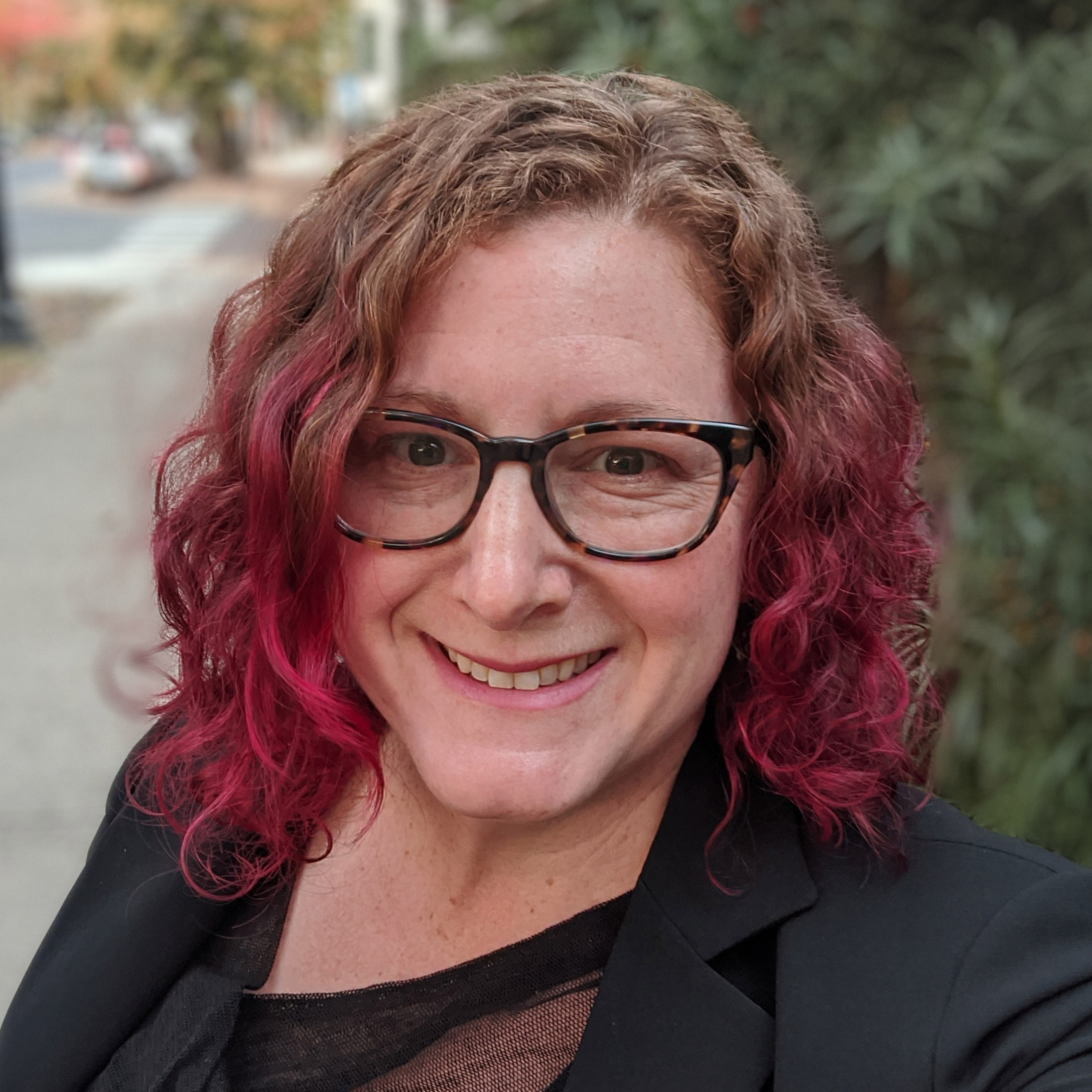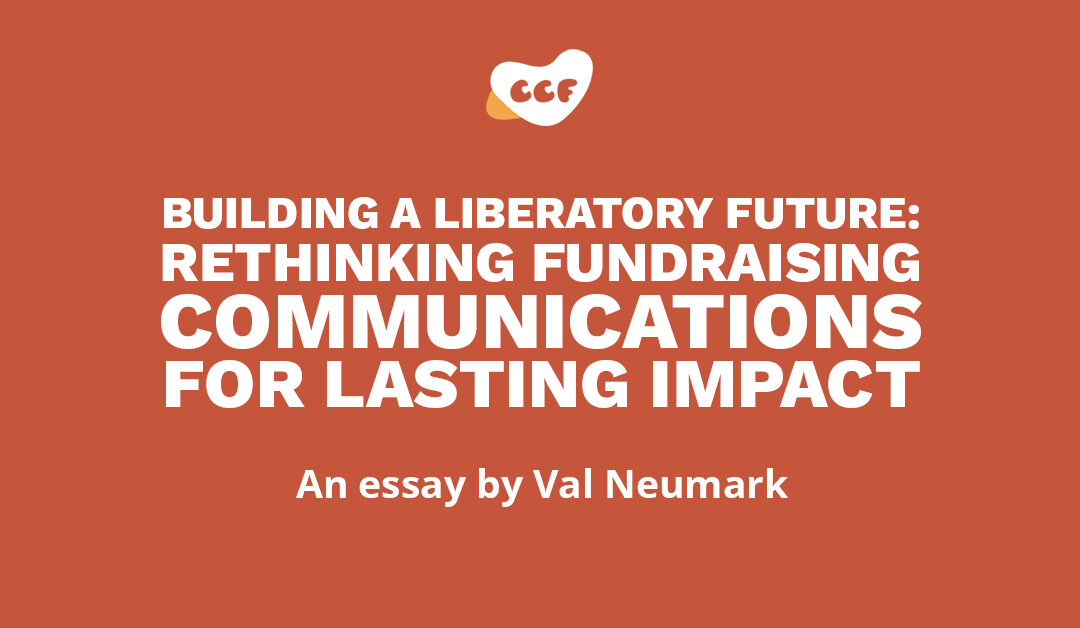By Val Neumark (she/they), Designer, educator, and facilitator using communications for transformational change
It’s time for a new approach to communications strategy that is founded on liberatory values.
“The number of donors who gave declined by 10 percent compared with last year.” – The Chronicle of Philanthropy, November 2023
A stark reality in fundraising confronts us: nonprofits continue to grapple with lower engagement and diminished donor support compared to previous years. It is time to reexamine the strategies we use to mobilize resources for social change.
In navigating the challenges of the election year, we stand at a critical juncture where the risk of perpetuating fear-based, white supremacy-laden tactics looms large.
It seems fewer and fewer people have been inspired to give because they are increasingly fatigued by how White Supremacy Characteristics like fear, either/or thinking, urgency, and, most of all, saviorism are being used repeatedly in fundraising communications. As I watched 2023 fundraising campaigns roll in and now observe the 2024 ask campaigns begin, I witness the continued leveraging of these characteristics.
Using these tactics may seem beneficial in the short term, but we cannot forget how they not only jeopardize the sustainability of our movements but perpetuate direct harm to our community members. Plus, people are simply tired of this approach and are yearning for something that feels more authentic and true, something that nurtures them instead of reminding them how they are falling short—this calls for a more liberatory approach.
In our pursuit of justice, equity, and liberation, we cannot afford to lose sight of the inherent humanity at the core of our endeavors, even if it feels impossible to raise money any other way—language matters.
Here is a brief overview of what I observed and some steps to do something about it:
How white supremacy characteristics show up in fundraising
Fear:
White supremacy needs us to be afraid that we have everything to lose if we interrupt it. When we are afraid, we lose touch with our values, truth, and power—making us even more susceptible to being manipulated by either/or thinking and false illusions of safety.
An example I saw in an email meant ultimately to encourage donations, used terminology like “rising authoritarianism and our democracy under threat.” I don’t know about you, but this type of tone just fills me with more anxiety on top of what I already navigate regularly. That is not how I want to show up in the world and certainly is not what compels me to donate these days.
Either/Or and Binary Thinking:
When we reduce the complexities of life and the nuances of relationships to “right vs. wrong,” “good vs. bad,” or “if you aren’t with us you’re against us” thinking, we reinforce urgency and lose track of a “middle way” of possibilities. Just look at the language used on pretty much every media outlet these days.
Here are a few examples I’ve seen in the media. “When there is a disaster, who is described as ‘looting’ and who is described as ‘finding necessary resources for survival’ (example: good vs. bad),” or another example that describes Palestinian “prisoners” being exchanged for Israeli “hostages” (example: right vs. wrong and if you aren’t with us you are against us)*. Language matters. (*credit Center for Story-based Strategy)
Our stories must retain complexity so that we can actually learn from each other rather than just living and agreeing with our own echo chambers.
The more time we spend engaging in curious conversations, the more we can bridge our shared humanity, needs, and values instead of continuing to cause even deeper polarization.
Urgency:
Where to begin with this one? It is so embedded in our society it is hard to see it let alone not use it.
How often do you feel like there is so little time you cannot have a thoughtful conversation or engage in an inclusive decision-making process? In fundraising communications, how many times have you read (or written) something along the lines of “Don’t wait until midnight on the last day to lend your support” or “Would you join us now in this urgent moment by rushing a gift?” Even “donate now” is implying an unnecessary amount of urgency to a single button if you really think about it.
So let’s take this moment to remember that hard work and meaningful rest are parts of a full cycle, and we need both so that we are less reactive and don’t burn each other out. Instead of planning everything at the last minute, let’s think about ways we can develop thoughtful work plans and stick to them, as well as using language that feels intentional and inclusive. We often say it’s “a marathon” but how many of us actually work in a way that is well-rested, grounded, and centered?
Saviorism:
This is a tough one to stomach sometimes because I think we all come into this work to be “helpers” of some kind. Our aim is to support or be in service to, but unfortunately, this intention can easily turn into something harmful when we reproduce the idea that donors are the “saviors” who can swoop in and “make a difference,” implying that the recipients are somehow lacking.
Here is an example I’ve seen more times than I can count, “Valerie, your support is essential…Give today to ensure we can continue to [insert generic project or program here] a reality!” or something along the lines of, “Only you can make a difference,” or “Your donation will save the lives of children.”
The question to ask yourself is, “Are my communications aimed at making my donors feel good about themselves more so than actually working against the systemic problems that affect the people we are raising the money for?” If so, you are probably using saviorism to compel people to give.
How we can behave differently, in a liberatory way
As Vu Le shared in a 2017 post about Community Centric Fundraising, “All fundraising professionals must be trained in anti-racism, systemic oppression, equity, wealth disparity, intersectionality, and other areas important to social justice.”
As communicators, our words have the potential to be a catalyst for transformative change. When we are more intentional with our words and actions—connecting authentically with the principles that drive us—we inspire our community members to engage and donate based on shared values and beliefs rather than saviorism, fear, or urgency.
So, how do we better equip ourselves for the work ahead? How do our fundraising and engagement efforts work towards dismantling institutional oppression rather than unintentionally perpetuating or reproducing it? It begins with doing the personal work to recognize how white supremacy characteristics are showing up within ourselves and our work.
Our team at rootid does this in a few different ways:
- We revisit Tema Okun’s White Supremacy Characteristics on a regular basis to self-assess how they might be showing up for us. It’s so easy to internalize perfectionism and urgency in a world that is moving so fast and expects so much.
- We reflect and discuss the Design Justice Network’s Principles and how we are upholding them in our relationships and work.
- We have aligned the way we work with the Liberatory Design process so that we can become more effective and thoughtful communicators for social change.
Liberatory Design is both a process and practice to help us, as individual communicators and fundraisers, generate greater self-awareness and habits that foster more sustainable social change. The process contains Mindsets and Modes that provide structures for creativity, “conversation, reflection, community-building, storytelling, and action.” This process not only helps us recognize how oppression and inequitable practices may be showing up in our work and relationships but also helps us to realize “alternative ways of being and doing.” (Liberatory Design deck card 2)
For example, the Mindsets “Practice Self-awareness” and “Recognize Oppression” ask us to acknowledge and challenge our assumptions by considering how our various identities position us in society relative to privilege and oppression. This then provides space to consider and discuss (with trusted accountability partners) how these identities may impact our work. (Liberatory Design deck cards 4 & 5)
“Inequities do not exist in a vacuum,” they are interconnected through structures, processes, practices, and policies. We must make time to notice and reflect on how our own identities and positional power shape what we see and hear, as well as how we frame the challenges we are facing in our greater communities.
Another aspect of putting your values into action is considering power dynamics within your team. The Liberatory Design process’ “Modes” begin by asking us to “See the System” as well as “Notice” and “Reflect.” When we take the time to “Notice” and “Reflect” on the equity challenges (inequitable patterns, structures, and dynamics) that are present within our “Systems” (work realities and relationships), we can begin to heal and then transform these inequitable patterns. (Liberatory Design deck cards 16 – 19)
How the Liberatory Design process and practices are applied will feel different for every person and within varying communities, just like figuring out how to create language that is inclusive and healing across the political spectrum will be unique to your context.
Using tools like Me Mapping and co-creating DACI and POP models and protocols help to name and shift the ways we communicate within ourselves, our teams, and our greater communities, and are the most effective ways to equip ourselves for sustained liberation.
Authentic change arises from a place of hope, inspiration, and shared values. Rather than relying on fear, either/or thinking, and urgency, let us commit to building fundraising and communications strategies rooted in liberatory language, principles, and vision. Liberatory language has the power to challenge and transform oppressive structures, fostering an environment where everyone’s humanity is acknowledged and centered. Again, language matters.
My greatest hope for 2024 is that our language and actions will become a more intentional force for the change we want to see. It’s time to rise above the allure of short-term gains and embrace practices that center and prioritize the shared values that remain at the heart of our movement work.

Val Neumark
Val (she/they) is a brand strategist, educator, facilitator, coach and co-founder of rootid (www.rootid.com). Through partnerships and collaborations, Val endeavors to connect people by co-designing anti-racist, anti-oppressive spaces and tools that facilitate strategic-thinking, community building and sustainable growth for non-profits and social impact organizations. In their free time, Val loves to hike, practice karate with their kid, and create mini, abstract paintings. You can follow Val’s work on Instagram at @wearerootid and @valartnstuff or connect with them on LinkedIn at /vneumark and /rootid
Discover more from CCF
Subscribe to get the latest posts sent to your email.


Yes, words create worlds – and we can and should use words with intentionality to create the world we want to see – a more equitable world in which all people thrive.
Thanks for this post Val.